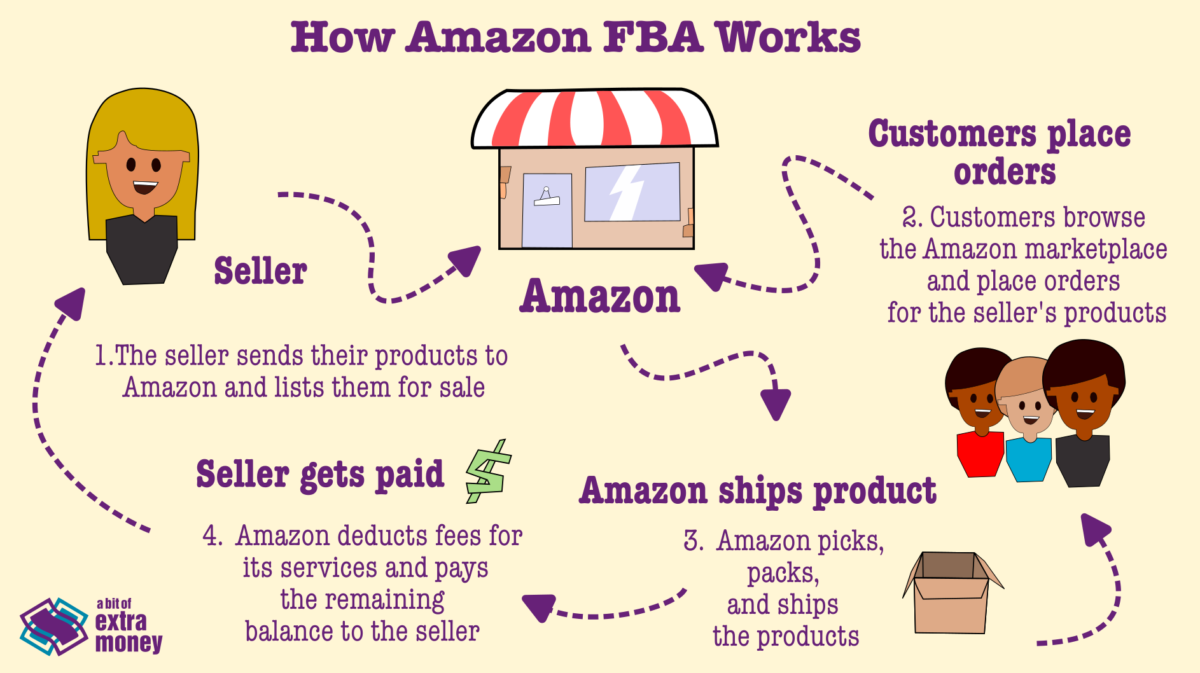How FBA (Fulfillment by Amazon) works.
FBA is a service provided by Amazon that allows sellers to store their products in Amazon’s warehouses. When a customer places an order for one of the seller’s products, Amazon will handle the storage, packaging, and shipping of the product to the customer.
Here’s how it works:
The seller sends their products to Amazon:
The seller sends their products to Amazon’s fulfillment centers, where they are stored until they are sold.
The seller creates product listings:
The seller creates product listings on Amazon’s marketplace, including details such as the product’s title, description, images, and price.
Customers place orders:
Customers browse the Amazon marketplace and place orders for the seller’s products.
Amazon picks, packs, and ships the products:
Amazon’s staff picks the product from the warehouse, packs it in a box, and ships it to the customer. Amazon handles all aspects of the order fulfilment process, including shipping, tracking, and customer service.
Amazon handles returns:
If a customer wants to return a product, Amazon will handle the return process and provide customer service.
The seller gets paid:
Amazon deducts fees for its services and pays the remaining balance to the seller.
The benefits of Amazon FBA for sellers include access to Amazon’s large customer base, the ability to offer Prime shipping to customers, and the ability to outsource the logistics of order fulfillment to Amazon. The fees for Amazon FBA vary depending on the size and weight of the product, as well as the storage fees and other services used.

What are the fees?
Fulfillment fees:
This is the fee charged by Amazon for picking, packing, and shipping your products to customers. The fee varies depending on the size and weight of the product, as well as the destination of the shipment.
Storage fees:
This is the fee charged by Amazon for storing your products in their warehouses. The fee varies depending on the amount of space your products take up and the time of year. Storage fees are higher during the peak holiday season, which runs from October to December.
Long-term storage fees:
If your products have been in Amazon’s warehouses for more than 365 days, you may be charged a long-term storage fee. This fee is charged twice a year, in February and August.
Removal fees:
If you want to remove your products from Amazon’s warehouses, you may be charged a removal fee. The fee varies depending on the size and weight of the product and the location of the warehouse.
Other fees:
Amazon also charges fees for additional services, such as labeling, prep services, and returns processing.
It’s important to factor in these fees when calculating your profit margins and pricing your products on Amazon. You can use Amazon’s FBA revenue calculator to estimate your fees and determine your potential profit.
What are Amazon joining FBA requirements?
To use Amazon FBA (Fulfillment by Amazon), there are a few requirements you must meet:
Professional seller account: You must have a professional seller account on Amazon to use FBA. This account requires a monthly fee of $39.99.
Eligible products: Not all products are eligible for Amazon FBA. Products must meet Amazon’s guidelines for size, weight, and other requirements.
Barcodes: All products must have a unique identifier, such as a UPC, EAN, or ISBN. Amazon also requires that each unit of your product have a scannable barcode so that it can be tracked in Amazon’s system.
Proper packaging: All products must be properly packaged to ensure they arrive at Amazon’s fulfillment centers in good condition.
Inventory management: You are responsible for managing your inventory levels and ensuring that you have enough inventory to meet customer demand.
Compliance with Amazon policies: You must comply with Amazon’s policies and guidelines, including those related to product listings, customer service, and returns.
Fees: As mentioned earlier, there are fees associated with using Amazon FBA. You must be able to cover these fees and still make a profit on your products.
By meeting these requirements, you can take advantage of the many benefits of Amazon FBA, including access to Amazon’s large customer base, the ability to offer Prime shipping to customers, and the ability to outsource the logistics of order fulfillment to Amazon.
Choose the right product
Choosing a product to sell on Amazon can be a challenging decision, and there are several criteria you can use to make an informed decision. Here are some factors to consider:

Market Demand:
The product you choose to sell should have a high demand on Amazon. Conduct thorough market research to identify products with high search volume, and check for the number of competitors selling the same product.
Competition:
It is important to evaluate the level of competition for the product you want to sell. If the product has too much competition, it may be difficult to make a profit. Use tools like Jungle Scout or Helium 10 to analyze the competition level and market saturation.
Profit Margin:
Consider the profit margin for the product you want to sell. Calculate the product’s cost of production, including shipping, packaging, and any additional fees. Determine the selling price and compare it with the expected profit margin.
Product Quality:
Ensure that the product you choose to sell is of high quality. Products with poor quality may result in negative customer feedback, which can affect your sales.
Brandability:
If you plan to build a long-term business, consider the potential for building a brand around the product. Products that lend themselves well to branding can lead to increased customer loyalty and higher profit margins.
Trends:
Keep an eye on the latest trends and new products in the market. These products may have higher demand and lower competition, making them an excellent choice for a profitable product.
Latest trends – may have higher demand.
New products – may have lower competition.
Find a supplier
Once you have a product in mind, find a reliable supplier who can provide you with the inventory you need. You can source products domestically or overseas, depending on your budget and preferences.

Finding a reliable supplier is crucial when buying goods to sell on Amazon.
Here are some practical steps you can take to find a reliable supplier:
Research:
Conduct thorough research on potential suppliers by reading reviews and checking their ratings. You can use platforms like Alibaba, Global Sources, and DHGate to find suppliers.
Check certifications:
Verify that the supplier has the necessary certifications, such as ISO 9001, to ensure they meet the required quality standards.
Request Samples:
Samples from potential suppliers to evaluate the quality of their products. This step can also help you assess their reliability and responsiveness.
Communication:
Establish clear and effective communication with potential suppliers to ensure that they understand your requirements and can meet your expectations.
Contract:
Once you have found a reliable supplier, create a written contract that outlines the terms and conditions of the agreement. This document should include details such as payment terms, delivery dates, product specifications, and quality standards.
Monitor Performance:
Continuously monitor your supplier’s performance, including the quality of the products and their responsiveness to your inquiries. This step can help you identify and address any issues that may arise.
Create your Amazon seller account
Sign up for a professional seller account on Amazon. This will allow you to list your products for sale, track your sales, and access other seller tools and resources.
There are several resources available to help you set up an Amazon seller account.
Here are some options:
Amazon Seller Central:
The Amazon Seller Central platform provides step-by-step guidance on how to set up an account. You can also find instructional videos and tutorials on the platform to help you navigate the process.
Third-Party Service Providers:
There are several third-party service providers that can assist you with setting up your Amazon seller account like sellerapp, a2x, webgility, and feedonomics. These providers offer a range of services, including account setup, product listing, marketing, and account management.
Freelancers:
You can also hire a freelancer who has experience setting up Amazon seller accounts to assist you with the process. Platforms like Upwork and Fiverr have freelancers who specialize in Amazon account management and can provide you with the necessary support.
List your products
Create a listing for your product on Amazon, including high-quality product images, detailed descriptions, and competitive pricing. Optimize your listing for search by using relevant keywords and providing as much detail as possible.

There are several software options available to help you create a listing for a product on Amazon.
Here are some of the most popular ones:
Jungle Scout:
Jungle Scout is an all-in-one tool that helps you find profitable products, research keywords, and optimize listings. It also includes features like sales tracking and competitor analysis.
Helium 10:
Helium 10 is a suite of tools that includes a product research tool, keyword research tool, and listing optimization tool. It also includes features like inventory management and Amazon PPC management.
AMZFinder:
AMZFinder is a tool that helps you manage your Amazon feedback and reviews. It also includes a listing optimization tool that helps you optimize your listings for better visibility and sales.
Perpetua (formerly Sellics):
Perpetua is an all-in-one tool that includes features like Amazon SEO, product research, and PPC management. It also includes a listing optimization tool that helps you optimize your listings for better visibility and sales.
SellerApp:
SellerApp is a suite of tools that includes a product research tool, keyword research tool, and listing optimization tool. It also includes features like inventory management and Amazon PPC management.
By using one or more of these software options, you can create an effective listing for your product on Amazon that is optimized for search and drives sales.
Monitor your sales
Keep an eye on your sales and track your performance using Amazon’s seller dashboard. Use the data to adjust your pricing, marketing, and inventory levels as needed.
Starting an Amazon FBA business can be a lucrative and rewarding venture but does come with some initial costs, hoops and pitfalls that you need to set up and carefully consider.
With careful planning and execution, you can build a successful business that generates a relatively passive income.
Are there online resources to learn more from?
Here some great blog, forums, and YouTube videos, to gain insights from experienced sellers.
there are several online resources available to learn more about setting up as an Amazon FBA seller.
Here are some of the best resources:
Amazon Seller University is a free resource provided by Amazon that offers video tutorials, guides, and webinars to help sellers learn how to set up and manage their FBA accounts.
Jungle Scout Academy: Jungle Scout Academy is a free resource that offers video courses on topics like product research, listing optimization, and PPC advertising. It also includes a free seller dictionary and blog with helpful tips and strategies.
Helium 10 Freedom Ticket: As mentioned above – Helium 10 Freedom Ticket is a comprehensive video course that covers everything from product research to listing optimization to marketing and advertising. It also includes access to a private Facebook group for additional support and resources.
Amazing Selling Machine: Amazing Selling Machine is a comprehensive course that teaches sellers how to start and grow a successful Amazon FBA business. It includes step-by-step video training, coaching, and support.
How much money can be made?
In 2023, according to recent statistics:
- 70% of Amazon sellers make more than $1,000 per month in sales.
- 25% of Amazon sellers make over $25,000 in monthly sales.
While the earning potential is significant, it’s important to note that factors beyond sales figures can impact the actual profit taken home by Amazon sellers.
To clarify, the average monthly sales for Amazon sellers in the USA are at least $1,000, with some top-performing sellers making over $100,000 per month. Additionally, 45% of Amazon sellers make between $1,000 to $25,000 per month, which could amount to $12,000 to $300,000 in annual sales.

Overall, the statistics show that there is significant earning potential for Amazon FBA sellers in the USA, with a majority earning at least $1,000 per month in sales. While sales figures are important, it’s crucial to consider the various factors that can impact a seller’s profit. With the right product niche, pricing strategy, and marketing efforts, Amazon FBA can be a lucrative business model for those who are willing to put in the hard work and dedication.

